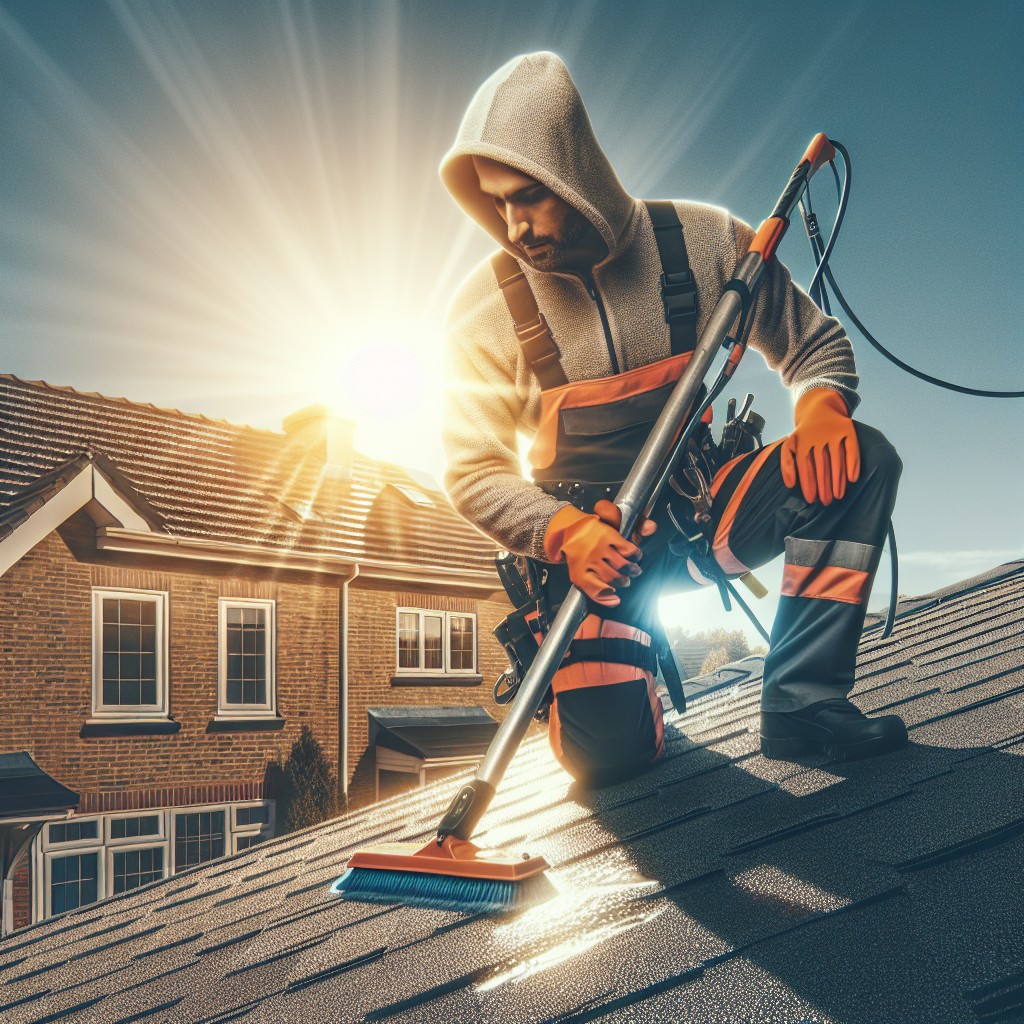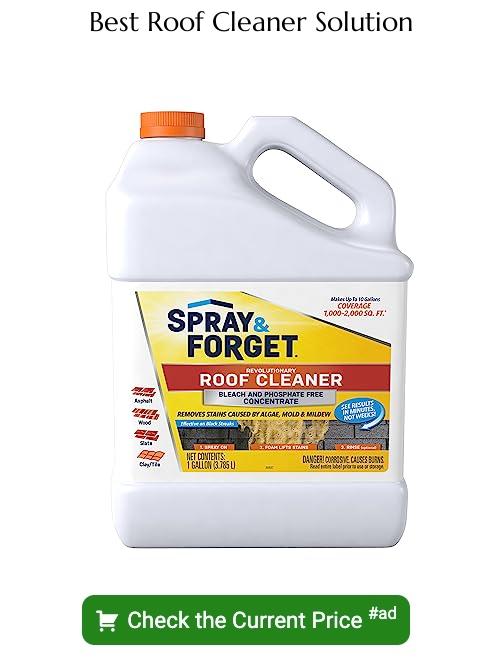Last updated on
Your home’s aesthetic appeal could tremendously increase by using the right roof cleaner, because aside from removing stubborn grime, it could also extend the lifespan of your roof.
Key takeaways:
- Roofs harbor damaging organisms like algae, moss, and lichen.
- Choose a cleaner that suits your roof type and the severity of growth.
- Consider the functionality and performance variables of the cleaner.
- Select the right cleaner based on its chemical composition.
- Prioritize eco-friendly options that are safe for the environment.
Understanding Roof Cleaners

Roof cleaners play a pivotal role in preserving the longevity and aesthetic appeal of your home’s rooftop. Their purpose extends beyond cosmetic upkeep, as they also help prevent the accumulation of organic materials that can damage roofing materials over time.
Key points to consider:
- Diverse Ecosystem on Roofs: Roofs often harbor algae, moss, and lichen – organisms that can deteriorate roofing substances, leading to leaks and structural weakness.
- Cleaner Types: Solutions range from harsh chemicals that kill growth and remove stains to gentler, eco-friendly options that provide a safe habitat for plants and animals around your home.
- Functionality: Cleaners can restore the roof’s original color, extend its life, and ensure that it remains functional by keeping the surface free from harmful biological growth.
- Performance Variables: The effectiveness of a cleaner can be influenced by the roofing material, the severity of growth, and the local climate. Not all cleaners are suitable for all types of roofs.
By understanding the necessity and functionality of roof cleaners, homeowners can make informed decisions about the care and maintenance of their roofs.
Types of Roof Cleaners

Roof cleaners can be broadly categorized based on their active ingredients and mode of action. Chlorine bleach-based solutions are known for their disinfecting power and ability to quickly remove algae, bacteria, and stains. However, they may discolor some roofing materials and harm plants if run-off is not carefully managed.
Oxygen bleach cleaners are another option. These are less harsh than chlorine bleach and are known for being environmentally safer. They effectively clean organic stains and are suited for a variety of roofing materials without the risk of discoloration.
Non-bleach, eco-friendly roof cleaning solutions are gaining popularity. These are typically hydrogen peroxide-based or utilize naturally occurring substances, such as citric acid and copper sulfate, to address roof contaminants. They are less aggressive and often require more time to see results but are preferable for those conscious of environmental impact.
High-pressure washers present a non-chemical alternative. While effective at dislodging dirt and grime, they can damage roofing materials if not used with care, especially on asphalt shingles or wooden shakes.
Finally, proprietary blends are available, often combining surfactants and mildewcides to target a range of growths and stains. These specialized mixtures are designed to offer a balance between effectiveness and gentleness on the roof’s surface.
Chemical Composition of Roof Cleaners
Roof cleaners can vary widely in their chemical makeup, directly influencing their cleaning power and potential impact on roof materials, vegetation, and the environment.
1. Alkaline Cleaners: Often containing sodium hydroxide, these are highly effective in breaking down organic matter but can be harsh on certain roof surfaces and need to be handled with care.
2. Acidic Cleaners: Formulated with ingredients like hydrochloric acid, these target tough mineral deposits like rust but require proper handling to avoid damage to both the roof and the user.
3. Chlorine Bleach-Based Cleaners: Known for their disinfectant properties, they excel in removing mildew and stains, yet their runoff can be harmful to landscaping and may corrode metal fixtures.
4. Oxygen Bleach Cleaners: Less harsh than chlorine bleach, these utilize sodium percarbonate as the active ingredient and are better for the environment, providing a gentler cleaning alternative.
5. Detergent-Based Cleaners: Combining surfactants with other ingredients, these solutions are effective for general cleaning and are typically safer for a variety of roof types and the surrounding ecology.
6. Enzymatic Cleaners: Utilizing natural enzymes to digest organic debris, these are eco-friendly and non-toxic, making them safe for use around pets and plants.
7. Copper Sulfate Solutions: Specifically targeting moss and algae, these are often used in preventive measures but may pose environmental concerns if not carefully managed.
Each type comes with distinct advantages and potential drawbacks, and selection should be based on the specific roof material, the nature of the dirt or growth being cleaned, and the environmental considerations of the area.
Environmentally Friendly Options
Selecting an eco-conscious cleaner can preserve your roof’s integrity while protecting the environment. Biodegradable solutions, which naturally break down without releasing harmful chemicals, are ideal for minimizing ecological impact. Look for products with plant-based ingredients and those that are phosphate-free and non-toxic to aquatic life, ensuring that runoff doesn’t contaminate waterways.
Vinegar-based formulations can be effective against mildew and mold, and they are often paired with essential oils like tea tree or eucalyptus to enhance performance and provide a pleasant scent. Baking soda is another green alternative, suited for removing algae without the use of heavy metals or bleach.
For those preferring a physical approach, pressure washing with plain water or gentle brushing can dislodge debris and moss from shingles, bypassing chemical use entirely. Remember, however, that some roofing materials might be damaged by high pressure or aggressive scrubbing, so always check the manufacturer’s recommendations before proceeding.
Application Methods for Roof Cleaners
Choosing the correct application method is vital for both the efficacy of the roof cleaner and the longevity of your roofing material. When using chemical solutions, a low-pressure garden sprayer is commonly recommended. This prevents damage to shingles often caused by high-pressure washing. For a gentler touch, applying the cleaner with a soft brush or a mop can distribute the product evenly while scrubbing away stubborn grime.
Foaming agents may be applied with specialized equipment that ensures the foam expands and adheres to the roof surface, maximizing contact time for better cleansing action. Always ensure you’re standing on a stable platform or using a ladder safely; taking care not to walk directly on the roof as this can dislodge granules from asphalt shingles or crack tiles.
For moss and lichen, pre-soaking the affected area helps the cleaner penetrate better. Ensure that you follow the manufacturer’s instructions regarding dwell time – the period the cleaner needs to sit on the surface before rinsing. This is where patience pays off, as proper dwell time can significantly enhance the cleaning process.
Remember to start from the lower sections of the roof and work your way up to prevent streaking and ensure thorough coverage. If rinsing is required, a low-pressure water stream from the hose is often sufficient. Avoid using high-pressure power washers, as these can damage roofing materials.
Lastly, always take into account weather conditions; avoid application on overly windy days to prevent spray drift, and don’t apply in rain to allow the cleaner time to work effectively.
Safety Precautions When Using Roof Cleaners
Prioritize personal protective equipment (PPE) — gloves, goggles, and non-slip footwear are essential to ensure skin and eye protection from harsh chemicals and to prevent slips on wet surfaces.
Read labels and follow instructions carefully to understand the safe use and potential hazards of the product, including the recommended dilution ratios and application techniques.
Ventilate the area if working with potentially fumigant substances to avoid inhalation of toxic chemicals.
Ensure ladders and scaffolding are secure and stable to prevent falls when applying cleaners to roofs. Using a safety harness is advisable when working at heights.
Be aware of the surrounding environment; protect plants and animals from exposure by covering them or using a cleaner that is safe for the environment.
Work in suitable weather conditions — a clear, calm day will minimize the risk of adverse reactions with the cleaner and is safer for working at height.
Keep children and pets away from the work area to prevent accidental contact with the cleaner.
Disposal of any leftover cleaner should be in accordance with local regulations to prevent environmental contamination.
Always have a first aid kit nearby for immediate response in case accidental exposure occurs.
Effectiveness On Different Materials
Roof cleaners demonstrate varying levels of effectiveness depending on the roofing material in question. For example:
- Asphalt shingles benefit from cleaners that focus on removing algae and mildew without damaging the granules on the shingle surfaces.
- Wood shakes respond well to cleaners that contain mildewcides and algae-resistant properties to protect the natural fibers of the wood.
- Metal roofs require cleaners that can address rust and oxidation without corroding the metal.
- Tile roofs, both clay and concrete, can handle stronger cleaning agents. However, special care must be taken with the porous surfaces to prevent the cleaner from causing erosion or discoloration.
- Slate roofs, while robust, can be susceptible to chipping, so choosing a gentle, non-acidic cleaner will avoid weakening the tiles.
It is critical to identify the type of roofing material before selecting a cleaner to ensure it is both effective and will not cause harm to the roof’s integrity. Always follow the manufacturer’s recommendations for the specific material to achieve optimal results.
How to Select the Right Roof Cleaner for Your Home
Selecting the appropriate roof cleaner starts with assessing your roof type. Asphalt shingles, tiles, metal, and wood all have specific cleaning needs and tolerance to chemicals. For instance, delicate materials like cedar require a gentle approach, whereas sturdy metal might stand up to more robust treatments.
Consider the cleaner’s composition. A cleaner with harsh chemicals like chlorine bleach may quickly tackle stains and mildew but can corrode fixtures and harm surrounding vegetation. Alternatively, oxygen bleach offers a more roof-friendly solution, though it may require more time to see results.
Also, assess the growth or stains you are tackling. Algae, moss, and lichen each respond differently to various cleaning agents. Products with copper sulfate are effective for moss, while a cleaner with a surfactant aids in breaking down algae’s protective layer.
Lastly, read labels for environmental impact. Eco-friendly cleaners minimize potential damage to your landscape and local ecosystem. Look for non-toxic, biodegradable options that provide a balance between efficacy and environmental stewardship.
Selecting the right cleaner is not just about immediate results; it’s about preserving the life of your roof without compromising the environment around your home.
Maintenance After Roof Cleaning
Proper maintenance following a roof cleaning can significantly extend the life of your roof and maintain its aesthetic appeal. To ensure lasting results:
1. Regular Inspections: Schedule semi-annual inspections to check for any accumulation of debris, early signs of algae, moss, or damage from weather conditions.
2. Trim Overhanging Branches: To minimize debris and reduce the risk of damage, keep nearby trees trimmed.
3. Gutter Cleaning: Clean gutters and downspouts regularly to prevent blockages that can lead to water pooling and growth of moss or algae.
4. Preventative Treatments: Consider applying a moss or algae inhibitor to prevent growth. This should be done yearly or as recommended by the manufacturer.
5. Address Repairs Promptly: Replace missing or broken shingles and fix any other roofing issues as soon as they are detected to prevent water damage and to maintain the roof’s integrity.
By adhering to these maintenance steps, the cleanliness and functionality of your roof can be preserved, ensuring it continues to protect your home while looking its best.
Addressing Roof Moss: Challenges and Solutions
Moss accumulation on roofs is more than an aesthetic issue; it can lead to roof damage by holding moisture against surfaces and lifting shingles. To address this problem:
- Begin with manual removal: Gently scrape the moss off with a soft-bristled brush, working downward to avoid lifting shingles.
- Apply a moss-specific cleaner: Choose a cleaner designed to kill moss spores. These are available in liquid form and can be applied with a sprayer.
- Opt for a gentler, slow-release solution: Zinc or copper strips installed at the roof’s peak can prevent moss growth. These metals create an inhospitable environment for moss as they leach out with rainwater.
- Consider preventive measures: Trim overhanging tree branches to reduce shade on the roof and promote drying, inhibiting moss growth. Ensure proper attic ventilation and insulation to reduce moisture buildup.
Remember, always prioritize safety when working on a roof and follow the roof cleaner manufacturer’s instructions for application and handling.
FAQ
What is the best thing to clean your roof with?
The best thing to clean your roof with is a mixture of Sodium Hypochlorite (bleach) and laundry detergent.
How do you clean a roof without damaging shingles?
To clean a roof without damaging shingles, apply a blend of water and bleach with a garden sprayer, let rest for 15-20 minutes, then carefully rinse with a low-pressure hose, avoiding use of a pressure washer due to potential damage.
Does roof cleaning really work?
Yes, roof cleaning does work as it can potentially double the lifespan of a roof.
Does wet and forget work on roofs?
Yes, Wet and Forget can effectively be used on roofs, as it has a distinctive hose end designed for broader coverage and higher reach.
What precautions should I take when cleaning a roof to ensure safety?
To ensure safety when cleaning a roof, one should utilize a safety harness, wear non-slip shoes, use sturdy ladders, guard against harmful chemicals, and never work during inclement weather or when the roof is wet.
How often should one schedule a professional roof cleaning?
A professional roof cleaning should be scheduled at least once every two years.
Can specific types of roof materials benefit from specialized cleaning solutions?
Yes, specific types of roof materials, such as slate, asphalt, metal, and tile, can greatly benefit from specialized cleaning solutions that are tailored to their specific material complexities and vulnerabilities.

